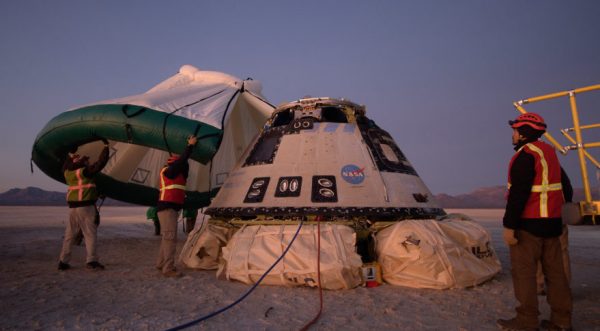Op-Ed | No, Houston, we do not have a problem – SpaceNews
by —

Not since the 1970s has the United States committed itself to design, build, and launch a crewed vehicle into orbit. After a long sojourn, NASA is now readying two spacecraft for low-Earth orbit destinations — Boeing’s Starliner and SpaceX’s Crew Dragon. Unsurprisingly, both have experienced setbacks. As NASA Administrator Jim Bridenstine aptly said: “this is, in fact, why we test.”
There is an irony to last week’s off-nominal orbital insertion of the Starliner, which led to it not being able to dock at the International Space Station. Had the vehicle been piloted, the engine burn miscue could well have been overridden and subsequently averted. But NASA’s prudent posture to validate the operational readiness of its human-rated modules has proven prescient. Test flights confirm what we know, but more importantly what we need to know.
Notably, key to the Starliner launch profile was to take a less direct route to achieve orbit in order to demonstrate safety parameters for future personnel and passengers. Compared to the delivery of low-Earth orbit satellites, nothing was exactly standard in this ascent. However, despite the inability to dock with the International Space Station, much has been gleaned from the mission, including data on navigation and guidance controls, environmental and life support functions, and active thermal systems.
As the United States nears a return to robust human spaceflight, these on-orbit anomalies will prove increasingly beneficial. Simply put, more pre-deployment data yields greater future success. NASA’s deliberate launch and learn approach to its commercial crew program is building out such a dataset and expanding its flight operations knowledge base.
Missing in the immediate attention to the Starliner news was how NASA arrived at this juncture. After the retirement of the Shuttle in 2011, NASA took a gamble and sought an entirely new business model for crew and cargo transport to the International Space Station. At the core of this concept was competition, the cornerstone of America’s economic prowess. Taken for granted today was the risk involved. And yet, borne by development of both Starliner and Crew Dragon, NASA’s bet on the private sector is paying off.
In this evolving industrial endeavor, nothing is static. Companies are ever accelerating their capacity to fulfill the demands of both government and commercial users. Along the way, every element of the manufacturing process is being reinvented and retooled, from 3D printing of rocket engines to reusing launch vehicles and crew capsules. Beyond the space sector, these newly applied design and material construction techniques are fundamentally contributing to overall U.S. industrial competitiveness.
As NASA continues to push the limits of exploration, both success and setbacks alike are instructive. The touchdown of the Starliner capsule in the soft sands of New Mexico is merely another step upon this long journey. While 2019 was a year of great strides, 2020 will be a giant leap in America’s return to human spaceflight.
Christian Zur leads the U.S. Chamber of Commerce’s policy formulation and advocacy on civilian and commercial space programs. His articles have been featured in publications such as Aviation Week, Defense News, Orlando Sentinel, Scientific American, SpaceNews, The Hill, and The Seattle Times.
Please enable JavaScript to view the comments powered by Disqus.






